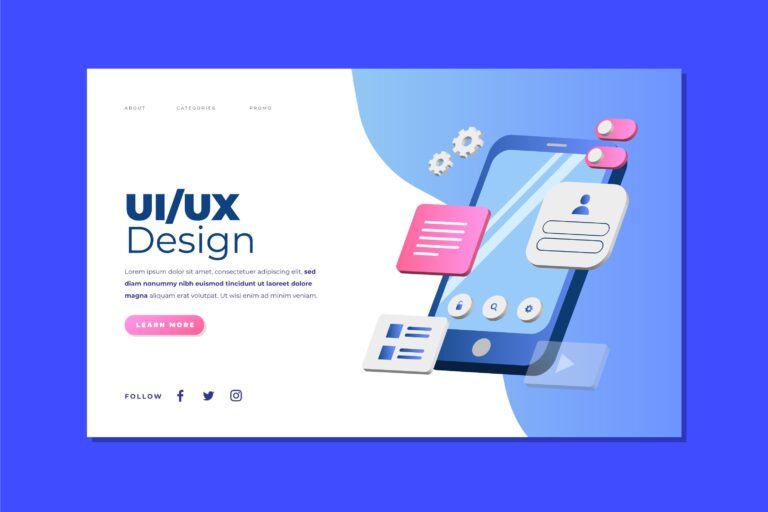The Future of Mobile UI Design: What to Expect in 2025 and Beyond
As technology advances and user preferences continue to evolve, mobile UI design is set to undergo significant transformations. In 2025 and beyond, we can expect innovative trends and design paradigms driven by advancements in artificial intelligence, augmented reality, and user-centric design principles. This article explores the future of mobile UI design and the trends that are likely to shape the landscape.
1. Minimalist and Clean Interfaces
Simplicity will remain at the forefront of mobile UI design. As users seek seamless and intuitive experiences, designers will focus on minimalistic interfaces that prioritize essential elements and reduce clutter.
Key Trends:
- Whitespace Utilization: More strategic use of whitespace to create clean layouts.
- Simplified Navigation: Reduced menu options for more direct user journeys.
- Microanimations: Subtle animations to provide visual feedback without overwhelming users.
2. Voice and Gesture-Based Interactions
Voice and gesture controls are becoming more sophisticated, offering new ways for users to interact with mobile applications.
Predictions:
- Voice-First Interfaces: Increased adoption of voice commands for hands navigation.
- Gesture Recognition: Advanced gesture controls for tasks like scrolling, zooming, and app switching.
- Integration with Wearables: Seamless gesture interactions between mobile devices and wearables.
3. Augmented Reality (AR) Experiences
Augmented reality will play a significant role in enhancing mobile experiences. As AR technology becomes more accessible, mobile UI designs will integrate immersive elements.
Applications:
- E-Commerce: Virtual try-ons for fashion and home decor.
- Navigation: AR overlays for real-world directions.
- Entertainment: Interactive AR games and experiences.
4. AI-Powered Personalization
Artificial intelligence will enable hyper-personalized experiences tailored to individual user preferences and behaviors.
AI-Driven Features:
- Smart Recommendations: Contextual content and product suggestions.
- Adaptive Interfaces: UI elements that adjust based on user behavior.
- Chatbots and Virtual Assistants: More conversational and intuitive interactions.
5. Dark Mode and Dynamic Themes
Dark mode has already gained popularity, and dynamic theming will take customization to the next level.
Trends:
- Dark Mode Enhancements: Improved color schemes for better readability.
- Dynamic Themes: Automatic theme changes based on time of day or user preferences.
- Energy Efficiency: Designs optimized for OLED screens to save battery life.
6. Seamless Cross-Platform Experiences
Users expect consistent experiences across devices. Mobile UI designs will increasingly focus on creating seamless transitions between smartphones, tablets, wearables, and desktops.
Strategies:
- Responsive Design: Interfaces that adapt fluidly to different screen sizes.
- Unified Design Systems: Consistent design elements across platforms.
7. Biometric Authentication and Security
Security and privacy will remain top concerns. Biometric authentication methods will become standard for mobile applications.
Innovations:
- Face Recognition: Faster and more secure authentication.
- Fingerprint Scanning: Enhanced accuracy and integration.
- Behavioral Biometrics: Analysis of user behavior patterns for added security.
8. 3D and Immersive Graphics
Advancements in graphic processing capabilities will allow for more visually stunning and immersive mobile UI designs.
Expected Trends:
- 3D Elements: Interactive 3D graphics for richer user experiences.
- Parallax Effects: Depth-creating effects for dynamic interfaces.
- Immersive Animations: Engaging transitions and interactions.
9. Sustainability-Focused Designs
As environmental awareness grows, sustainability will influence mobile UI design.
Eco-Friendly Trends:
- Energy-Efficient Designs: Interfaces optimized for lower power consumption.
- Minimal Data Usage: Lightweight designs to reduce data transmission.
- Sustainable Color Schemes: Use of colors that are less visually straining.
10. Inclusive and Accessible Designs
Inclusivity will be a major focus in mobile UI design, ensuring that applications are usable by a diverse range of users.
Accessibility Enhancements:
- Voice Navigation: Improved accessibility for visually impaired users.
- Customizable Interfaces: Options for font size, color contrast, and layout adjustments.
- Haptic Feedback: Enhanced tactile responses for better user engagement.
Conclusion
The future of mobile UI design is exciting and filled with possibilities. As technology continues to evolve, designers will need to stay ahead of emerging trends and prioritize user-centric design principles. By embracing advancements in AI, AR, personalization, and accessibility, mobile UI designs will create richer, more engaging, and inclusive experiences for users.
The key to success in this evolving landscape will be continuous innovation, a deep understanding of user needs, and a commitment to creating interfaces that are both functional and delightful.
Devoq is a leading UI/UX design agency with a strong presence in UI/UX Design Agency in Kozhikode and UI/UX Design Agency in Kochi , offering innovative digital solutions tailored to businesses of all sizes. The agency is known for its user-centered design approach, creating seamless and visually appealing interfaces for websites, mobile applications, and enterprise platforms. With a focus on enhancing user experiences and brand engagement, Devoq combines creative design, strategic thinking, and the latest technologies to deliver impactful digital products. Their expertise in design strategy and user research ensures that businesses in Kozhikode and Kochi stay ahead in the competitive digital landscape.












